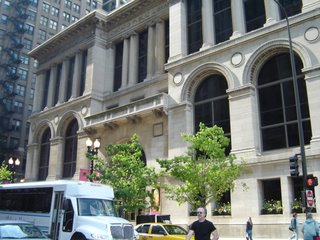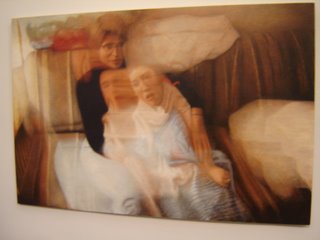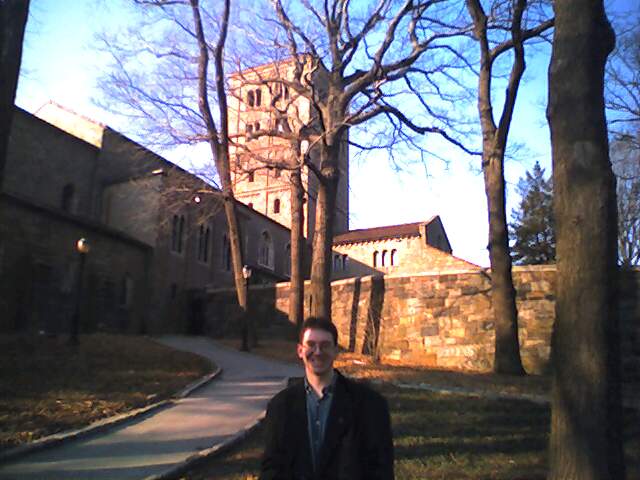Chicago Cultural Center
 While walking around downtown Chicago, I happened to run into the Chicago Cultural Center, a free museum run by the city of Chicago.
While walking around downtown Chicago, I happened to run into the Chicago Cultural Center, a free museum run by the city of Chicago. I was joined by my old FAPC friend Kyle Smith, who was also on a business trip. This marks the first time I've met someone else on a business trip while I was on a business trip.
I was joined by my old FAPC friend Kyle Smith, who was also on a business trip. This marks the first time I've met someone else on a business trip while I was on a business trip. The museum is housed in a ne0-classical building:
The museum is housed in a ne0-classical building:Designed in the beaux-arts style by the Boston firm Shepley, Rutan and Coolidge, the Chicago Cultural Center was completed in 1897 and dedicated as the city's original Chicago Public Library. Completed at a cost of nearly $2 million, this remarkable monument was inspired by the neo-classical style of the World's Columbian Exposition held in Chicago in 1893.
The building's structure consists of three-foot thick masonry walls faced with Bedford limestone that are set 104 feet above a granite base. Sumptuous materials used in the interior design include rare imported marbles, fine hardwood, stained-glass, and polished brass, as well as mosaics of Favrile glass, colored stone and mother-of-pearl. The building's most notable features are its spectacular stained-glass domes. The 38-foot dome in the Preston Bradley Hall in the south end of the building is the world's largest Tiffany stained-glass dome, valued at an estimated $35 million. In the north end of the building, the stained-glass dome in the G.A.R. Rotunda was executed in an intricate Renaissance pattern.
 Further renovations turned it into what it is today:
Further renovations turned it into what it is today:The firm of Holabird and Root completed a renovation of the building in 1977, when it was rededicated as the Chicago Public Library Cultural Center. A designated Chicago Landmark listed on the National Register of Historic Places, the building was reborn as the Chicago Cultural Center in 1991, when the Library relocated to the new state-of-the-art Harold Washington Library Center. The Chicago Cultural Center is now the home of the Chicago Department of Cultural Affairs and one of the city's Visitor Information Centers.
 I was struck by its photography exhibit, which has some great pieces. This one, "Psalm Forty-Two" by John Dugdale, was taken in 1996. More of his work, in which he seems to like the color blue, may be found here. His work is more impressive when you learn that he turned his attention to his fine art after he lost his eyesight in 1993 to CMV retinitis, an AIDS related illness. He uses an older photo process to compensate for this:
I was struck by its photography exhibit, which has some great pieces. This one, "Psalm Forty-Two" by John Dugdale, was taken in 1996. More of his work, in which he seems to like the color blue, may be found here. His work is more impressive when you learn that he turned his attention to his fine art after he lost his eyesight in 1993 to CMV retinitis, an AIDS related illness. He uses an older photo process to compensate for this:While blindness ended his commercial career, he found himself free to explore his fine art, using friends and family members as studio assistants. Using an 8 x 10" camera, Dugdale created ways of setting up a photograph, relying on others to focus the camera. Working with the blue and white hues of the cyanotype, a process developed in 1841 which uses the sun to expose the sensitized paper, Dugdale found a way to avoid the darkroom and the harsh chemicals he can no longer endure and still create sensitive, affecting images. The results of his persistence are images which are both poignant and delicate, contemplative yet quietly potent. Dugdale relies on his memory to compose still lives, nudes and self-portraits which resonate with sadness, beauty, death and the joy of life.
 This is "Shift" by Tim Lowly, taken in 2002. Lowly is apparently a faculty member of North Park University where some of his work is on display there and on his website.
This is "Shift" by Tim Lowly, taken in 2002. Lowly is apparently a faculty member of North Park University where some of his work is on display there and on his website. The most shocking photo I saw today though was "Pfc. Alan Jermaine Lewis" from the "Purple Hearts Series," taken in 2003 by Nina Berman. Lewis lost both of his legs serving our country in Baghdad in our current Iraq war:
The most shocking photo I saw today though was "Pfc. Alan Jermaine Lewis" from the "Purple Hearts Series," taken in 2003 by Nina Berman. Lewis lost both of his legs serving our country in Baghdad in our current Iraq war:His Humvee, its doors removed because of the intense heat, hit a land mine. One of Lewis' legs was blown off and the other was so badly injured that it couldn't be saved, he said. Debris struck his left eye and singed parts of his face. His left forearm was broken in six places.
"From what I understand, the vehicle bounced up and came down," he said. "I wasn't unconscious or anything. It was more like a weird feeling for a second, and then everything went black, and then I came to. I couldn't see out of my left eye, and everything was foggy, and I started yelling for help."
Lewis is one of more than 1,100 soldiers who have been wounded since the war began in March - more than twice the number wounded during the Persian Gulf War in 1991. With little public notice, that number has climbed steadily; in August, nearly 10 troops a day were injured.
There were lots of other interesting pieces of artwork. My only criticism of the place is that it seemed to be oddly organized. At one point Kyle and I got lost trying to find other artwork, and eventually gave up.
But it was certainly worth the price of admission, and it exposed me to some photographers I never heard of. If you're in Chicago and you have an hour or so, check it out.



0 Comments:
Post a Comment
|<< Home